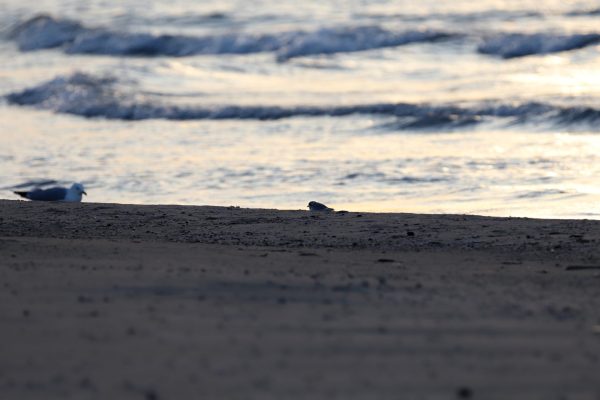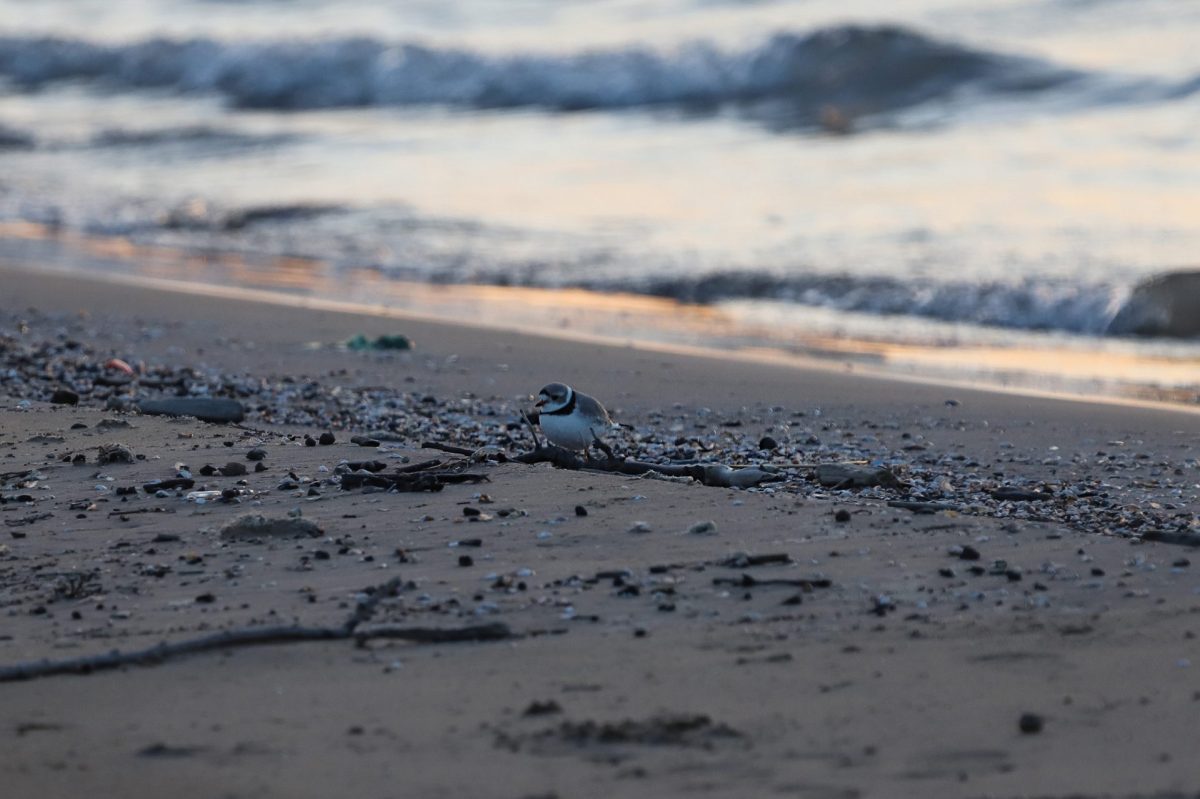As the sun sets over the beach at Montrose Point Bird Sanctuary, a small crowd emerges from the wooded entrance and floods to the hooked pier that juts along the sand. They move independently of one another, glued to binoculars and viewfinders. They are searching for a piping plover in the sand.
Piping plovers — a rare find in these parts — are a threatened species of shorebird that migrate around the Great Lakes region from spring until autumn. The small, tan birds run and hide in the dunes of Montrose Beach, making them difficult to spot with the naked eye. In the winter, they migrate to southern states on the Atlantic and Gulf coasts.
Part of the allure of the birds is due to the media craze that surrounds them. Each year, articles are published that give updates on the growing family tree of piping plovers at Montrose Point.
“It’s like a soap opera,” said Erick Masias, an organizer with Chicago BIPOC Birders.
The reports of two plovers pairing up, or an untimely death, fuel the public’s relationship to the birds.
“Some have passed away when they initially started nesting … I think one of them got eaten by a raccoon,” Masias said. “There’s a lot of turmoil that comes with plovers.”
While there are no documented cases in recent years of raccoon attacks, plover nests are targets of larger species. They disappeared from Chicago-area beaches in the 1950s, but made a reappearance in Illinois in 2015 when they were seen nesting. In 2019, the first piping plovers were fledged at Montrose Beach.
Chris Hareland is a birder who traveled from Evanston hoping to see the piping plovers. Having first started birding last year, he is among the small group of birders who have searched Montrose Point for a pair of plovers in recent weeks.
“I’ve heard for a while how endangered they were,” Hareland said. “They are nesting in such a populated area like Chicago, not in some remote place you have to trek all the way out to. It’s very accessible.”

Birding has become a popular activity in recent years as a younger crowd has joined the ranks, flocking to outdoor preserves in an attempt to identify local species. It exploded in popularity during the Covid-19 pandemic, when people were looking for ways to get out of the house while still remaining away from others. It can also be done at home, out the window.
In Chicago, birders have taken extra measures to protect the vulnerable piping plovers from one of the busiest beaches in Chicago. In 2019, Chicago Bird Alliance, the Chicago Ornithological Society and the Illinois Ornithological Society banded together to create Chicago Piping Plovers, a volunteer organization dedicated to protecting the nests and breeding grounds of the species.
Tamima Itani is the coordinator for Chicago Piping Plovers. She works as a volunteer at Montrose Point as a plover monitor. Her work as a monitor helps to establish a foothold for the species to prosper in the area.
In the Great Lakes region, there are currently only 81 known breeding pairs of piping plovers.
“It is very important for us to preserve this species that nests on the beach,” Itani said.

Itani says that protecting the few plovers at Montrose Beach benefits other small birds. The beach area is monitored daily, and nests are protected from predators that endanger them.
“A lot of short birds take advantage of it by stopping their resting refueling before they continue on to the Atlantic,” Itani said.
The first pair of plovers to nest in Chicago since the 1950s, Monty and Rose, catapulted the species to recognition in 2019. They hatched 10 plovers in their lives. Monty died in 2022 from illness, while Rose disappeared and is presumed dead.
Last year, the offspring of Monty and Rose, Imani and Sea Rocket, became a pair, and they hatched Nagamo, introducing a new plover to the Chicago beach.
This year, there have been two plovers spotted on the beach, Pippin and Imani.
Masias says that the public often hears about the success stories that weave the web of the piping plover soap opera.
“There are chicks, and more characters that get introduced to the story,” Masias said. “It’s like watching reality TV. … We have an eligible bachelor every year.”
Related Stories:
Support Student Journalism!
The DePaulia is DePaul University’s award-winning, editorially independent student newspaper. Since 1923, student journalists have produced high-quality, on-the-ground reporting that informs our campus and city.
As the funding model for journalism changes, we rely on reader support more than ever. Your donation helps us fund the reporting that keeps our community informed. Donations are tax deducible through DePaul's giving page. Click the button below to donate.




